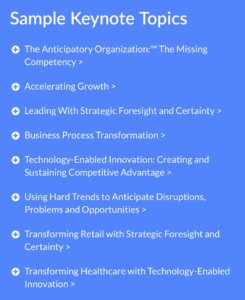There isn’t an organization on the planet that dismisses the value of highly motivated employees. Motivated people not only do their jobs better on a consistent basis, they also remain with an organization longer.
Financial reward is perhaps the most obvious means of boosting employee motivation. But sometimes there simply aren’t sufficient financial resources to foster an environment where positive motivation dominates.
Fortunately for Anticipatory Organizations, money isn’t the only way to motivate employees.
Encourage Innovation at Every Level
My principles of Hard and Soft Trends and the Three Digital Accelerators (the exponential growth of computing power, bandwidth and digital storage) are making continuous innovation an imperative, not just an option. Consider Uber, Kickstarter and any number of other companies that changed the entire landscape of their industries with game-changing innovation. Others that failed to innovate at that same level merely struggled.
But innovation of all sorts isn’t just a form of significant competitive advantage. It’s also a powerful means of motivating employees. Building and nurturing an organization-wide focus on innovation also promotes a powerful sense of engagement and belonging. The message isn’t keep your head down and stay the course—rather, keep your eyes open looking for ways to solve recurring problems rather than waiting for someone else to do it. Think about a feeling that we are all counting on each other to help make everything we do even better by contributing your best ideas in an active way. That’s powerful inclusion.
Make Praise Public—And Other Ideas
Everyone likes to be told they’re doing a good job—it’s one of the most effective forms of motivation. In today’s digital world that’s filled with email, a short handwritten letter of gratitude can be a very powerful form of motivation and pride.
Another big one that is often overlooked in today’s fast-paced world, where everyone is being asked to do more with less, is singling out outstanding work in a more public forum. Gather the organization, team members or any other group you think appropriate and cite an employee’s effort and contributions. Not only can that boost that particular employee’s motivation level, it also lets others know that energy and commitment are acknowledged for all to see.
Further, if you’re not certain how best to boost employee motivation if cash is tight, don’t be afraid to ask what people would like to receive. Some may welcome something as straightforward as a special parking spot next to the main entrance, one day working from home or an hour or two earmarked each week for work on some sort of innovative product or idea.
That highlights another important element of my Anticipatory Organization Model™—never losing sight of the role of the “ideator.” Often, after an idea is suggested and subsequently developed, changed and nurtured, the person who offered the original idea in the first place can get lost in the shuffle. Don’t let that happen—boost motivation by acknowledging everyone involved in the effort, including the person who hatched the idea from which it all came.
Never Forget—Reward the Behavior You Want
Many of the organizations with which I work make a core mistake in trying to change behavior—they overlook the need to reward the new behavior they hope to foster. In some cases, that can be attributed to failing to change the compensation structure to reflect the new behavior you want to foster. Also keep in mind that the reward doesn’t always have to correlate with money.
With that said, consider those steps that will directly foster and contribute to a motivated employee mindset:
- Is your technology up to date or is it aging and less effective, even an ongoing source of frustration for employees? An organization willing to invest sufficiently in productive technology can only motivate employees who see that as a commitment to helping them do their jobs better.
- Are you helping to bridge any gaps between younger and older employees? In many organizations, younger employees may feel that older colleagues “just don’t get it,” while older employees may see their younger counterparts as arrogant know-it-alls. Instead, encourage motivation by building an environment where everyone’s strengths and perspectives are recognized. That can foster an environment of trust—yet another factor that boosts motivation.
Ultimately, take time to consider thoughtfully those steps that can encourage a pervasive environment of motivation in your organization. You know it’s important, and money is by no means the only way to make it happen.
Daniel Burrus has been trusted by leaders from Fortune 500 Companies, the Pentagon and Heads of State to deliver a message that accurately predicts future trends and identifies game chaning opportunities before the competition. See some of Daniel’s Sample Keynote Topics below:








Comments